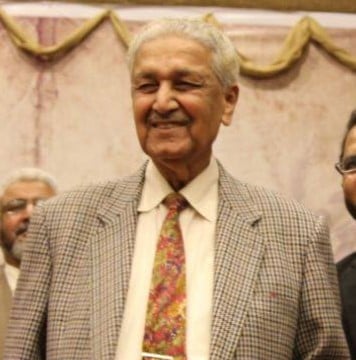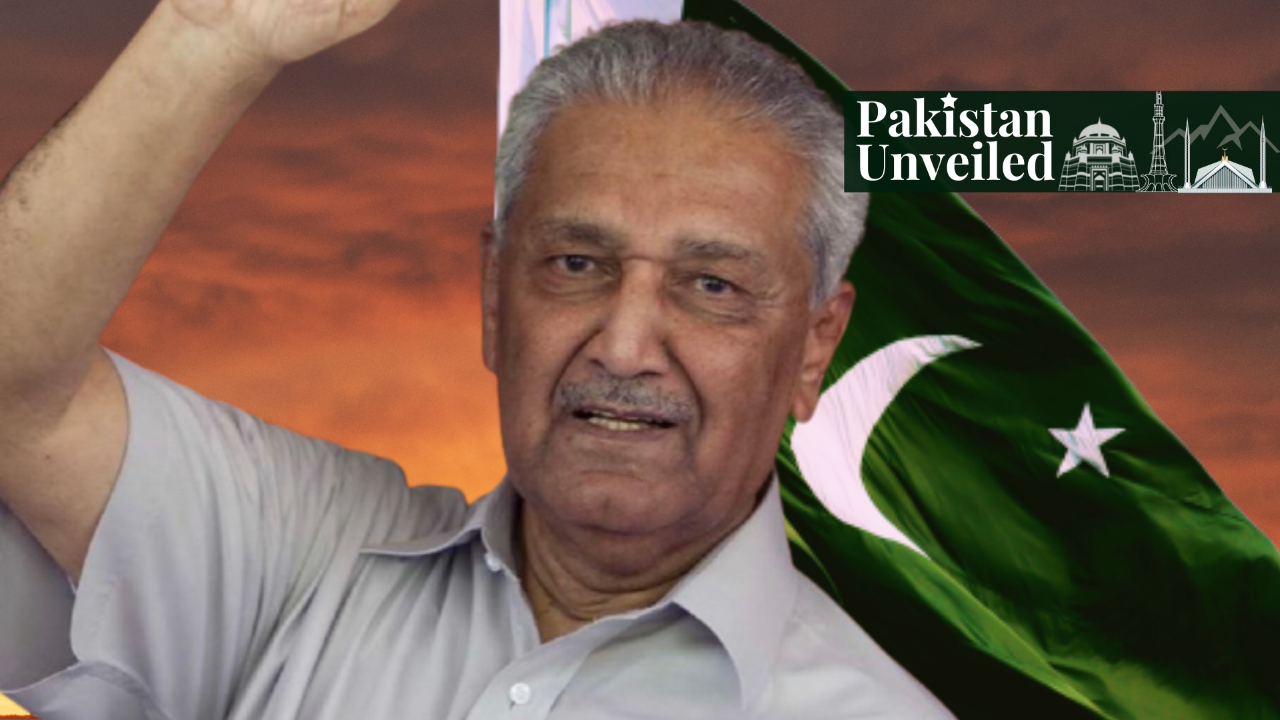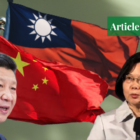Mr Ziyad Sheikh is an engineering student interested in physics, python, gaming, and reading non-fiction texts.
Early Life & Education
This piece is a biography of Dr Abdul Qadeer Khan, a metallurgical engineer, a nuclear physicist, and the father of Pakistan’s atomic weapons program. He was born on the 1st of April 1936 in India, Bhopal State. By 1952, Abdul had completed his matriculation from a local school in Bhopal. Then he took the Sindh Mail train to Pakistan from India, mainly because the government had turned against certain groups of people and there was a lot of religious violence that took place during that time.
Germany
Dr Abdul Qadeer Khan attended the DJ Science College for some time and then transferred to the University of Karachi. In 1956, he graduated with a Bachelor of Science in Physics along with a concentration in solid-state physics. Abdul started working for Karachi Metropolitain Company as an inspector for measures and weights in the same year. He worked in Karachi Metropolitan Company till 1959, then he applied for a scholarship at the Technical University in West Berlin, where he studied material science.
The Netherlands
After doing very well at Technical University, he switched to the Delft University of Technology in the Netherlands. After 2 years, Abdul Qadeer Khan graduated from Delft University with an Engineering degree in Material Science.
He then pursued a doctoral programme in metallurgical engineering from Belgium’s Katholieke Universiteit Leuven. In 1972, he graduated with a PhD in Metallurgical Engineering. His PhD thesis was based on fundamental work on martensite and its extended industrial applications in the field of graphene morphology.
He later joined an Amsterdam Engineering Firm (Physics Dynamics Research Lab). They were subcontractors of the Urenco Group which was a British nuclear fuel Company and were involved in uranium enrichment in several countries including the Netherlands. In May 1974, India did a surprise nuclear test known as the Smiling Buddha, which made Khan want to contribute to the PAEC (Pakistan Atomic Energy Commission) and build an atomic bomb for Pakistan.
In order to do this, Dr Abdul Qadeer Khan met with Pakistani officials in Hague, but they simply refused him. Khan wasn’t aware that Munir Ahmed Khan, a reactor physicist, and his team of scientists were already making progress towards the first atomic bomb of Pakistan.
Led by Bashiruddin Mehmood, a team was dispatched by PAEC to meet with Khan in Almelo and gave him the letter sent by PM Zulfiqar Bhutto. In the letter, Khan was called to Islamabad to meet with PM Zulfiqar Bhutto.

Return to Pakistan
When Dr Abdul Qadeer Khan met PM Zulfiqar Bhutto, he had been instructed to learn more about centrifuge technology while also providing consultation for Project 706. As Urenco Group became suspicious of Khan, they transferred him to a less sensitive section. This made Khan fear for his safety in the Netherlands, and so he decided to return back to Pakistan.
In 1976, Dr Abdul Qadeer Khan joined the enrichment division of the atomic bomb programme of PAEC where he collaborated with Khalil Qureshi, a physical chemist. Khan was very important in the programme, as his calculations were vital for nuclear research. Khan pushed forward his idea for the feasibility of weapon-grade uranium, but all efforts were being put to produce military-grade plutonium.
Khan refused to perform calculations as he had a fallout and became a source of tension within the atomic bomb programme. This is because he wasn’t selected as the director of the uranium division, and instead, Bashiruddin Mehmood was selected for the position. A few years went by and a report was sent to PM Zulfikar Bhutto about the inactivity of the enrichment program.
PM Zulfikar Bhutto then suggested that Khan take over the enrichment program instead of Mehmood who had separated the programme from the PAEC by founding the Engineering Research Laboratories.
Suspicions
In 1979, the Dutch government located Khan as a suspect of nuclear espionage. A criminal complaint was lodged against Khan in a local court of Amsterdam which resulted in Khan being sentenced in absentia from 1985 to 1989. Khan hired Attorney S.M. Zafar who, on a technical ground, vindicated Khan.
During Zia’s administration, Pakistan’s nuclear capability was kept discreet from the United States. However, President Zia nearly lost his patience with Khan, as he tried to give an interview to a local US media regarding the existing enrichment programme.
In 1987, Dr Abdul Qadeer Khan again gave an interview in India, where he gave shocking statements like “Americans have been well aware of the atomic bomb programme of Pakistan”. All these events led President Zia to warn Khan of the severe repercussions he could potentially face in case he doesn’t take back his statements given to the media.
A parallel electromagnetic isotope separation programme was led by G.D Alam at the Air Research Laboratories. Alam achieved great things, including being able to perfectly balance the rotation of a 1st generation centrifuge at 30,000. Eventually, Khan was able to perfectly balance the machine under gravity and make the 1st generation design of a fully functional centrifuge.
Pakistan Becomes a Nuclear State
This led Dr A. Q. Khan to be given several accolades by the military who called him “Centrifuge Khan”. Khan had also published papers on the analytical mechanics of balancing rotating mechanics. In 1998, Pakistan had its 1st ever nuclear test, Chagai-I which was a response to the Nuclear Test Pokhran-II done by India.
In the nuclear test, Chagai-I, Khan wasn’t selected as the head of the project, but he made viable contributions to the design of the centrifuges. Tasneem Shah and Alam solved the differential equation, which was concerned with the rotation around a fixed axis under influence of gravity. Khan wanted to only work with high enriched uranium in order to design a gun-type device.
The major credit for the Chagai-I was given to Khan, which wasn’t taken well by a majority of Khan’s colleagues. From 1987 to 1989, Khan leaked secret knowledge of centrifuges to Iran without telling the government of Pakistan. This led the EU to pressurize Iran to enforce tougher inspections on its nuclear programme.
Legacy
After several years, Dr Abdul Qadeer Khan was put under house arrest in 2004 because he was accused of illegally selling nuclear secrets. He was then pardoned by President Pervez Musharraf after he had confessed to the charges. Later, he applied for a lawsuit against the federal government of Pakistan in a court in Islamabad and was acquitted on 6th February 2009.
The United States under Obama’s administration reacted negatively to this verdict, and an official statement was issued, declaring that Khan was still a “serious proliferation risk”. In 2007, Khan was paid homage by Prime Minister Shaukat Aziz. In 2012, Khan announced the formation of his political advocacy group “Tehreek-e-Tahaffuze Pakistan”.
In August 2021, Dr Abdul Qadeer Khan contracted COVID-19 and was sent to the Research Laboratories Hospital. He passed away on 10th October 2021 at the age of 85. He was provided with a state funeral and was buried in the H-8 graveyard in Islamabad. Prime Minister Imran gave his condolences and said that “For the people of Pakistan, He (Abdul Qadeer Khan) was a National Icon”.
If you want to submit your articles and/or research papers, please check the Submissions page.
The views and opinions expressed in this article/paper are the author’s own and do not necessarily reflect the editorial position of Paradigm Shift.



















